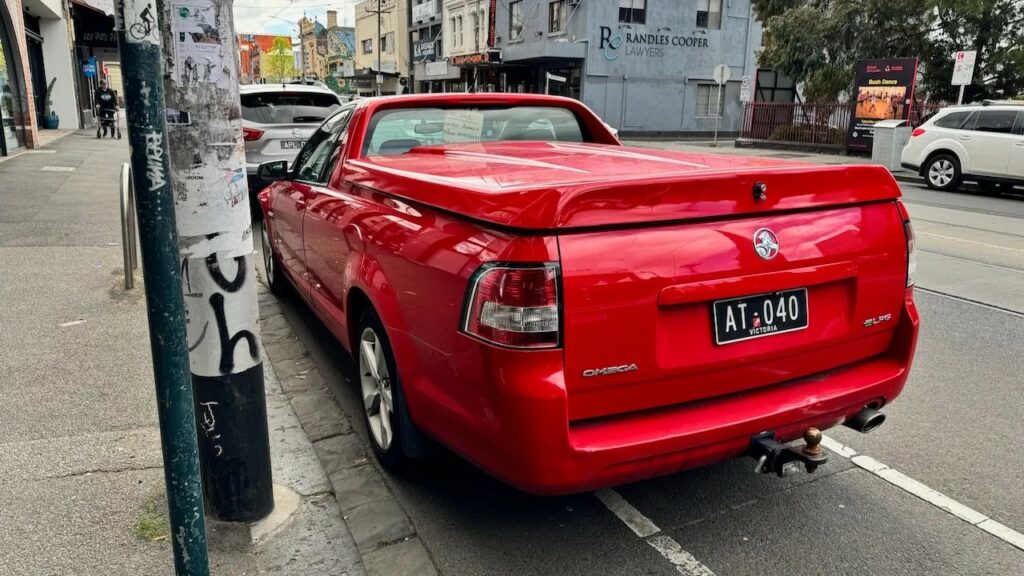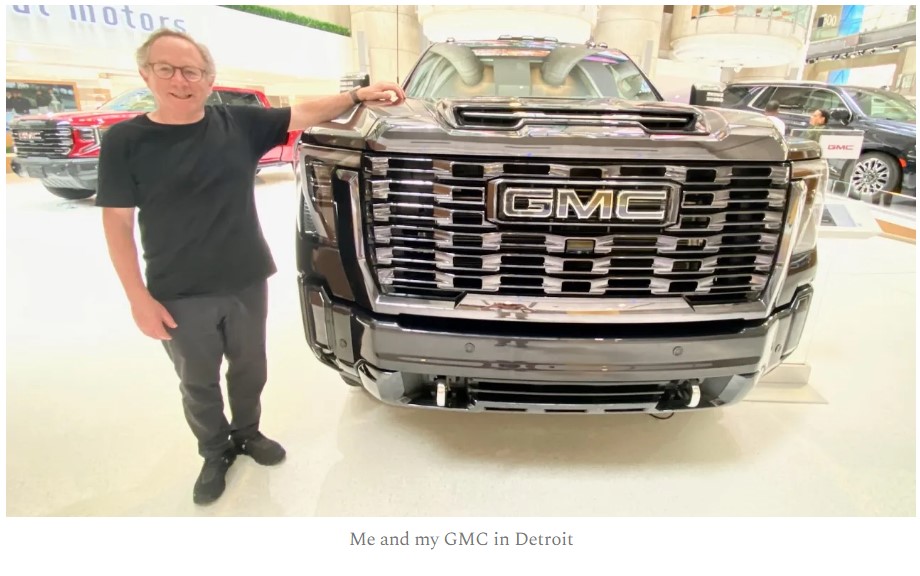Why electric cars of the future might be smaller, safer, and fewer
by Lloyd Alter
Carbon Upfront
There is a sense of humor here being shown by Lloyd. He is asking Elon Musk to build differently than what he would do if planned by the market. Granted electric vehicles have been a part of what Tesla offers. Lloyd is asking Elon to go a step farther and build something smaller that the US car manufacturer behemoths have been building. Lloyd wants it even smaller and on a car suspension rack. It makes sense for many homeowners rather than what GM, Fords, and Stellanis’s are offering. It fills a niche not occupied by anyone else that I know of today (maybe I am missing something?).
I think it is a great idea for suburbia.
Years ago, when Elon Musk announced he was going to build a pickup truck . . . I asked Please, Elon Musk, Give Us an Electric El Camino, writing:
In 1932, Ford Australia produced a cross between a car and a truck because the wife of a farmer asked for “a vehicle to go to church in on a Sunday and which can carry our pigs to market on Mondays.” In the fifties, the Ford Ranchero and the Chevy El Camino were exactly that — the comfort and elegance of a coupé with the utility of a pickup truck. Now, pickups are driven by people who never get closer to a pig than a pound of bacon in the Walmart bag, but they are much more like trucks: high, heavy and deadly to everyone around them.
When in Australia recently, I was thrilled to see that people are still driving these; I saw quite a few of them in Melbourne. Alas, they stopped making them in 2017 as bigger pickups took over the market. Electric versions of these would make so much sense; It would be lower and safer for pedestrians, both because of better visibility and a less dangerous front-end design, but also, being lower and lighter, would go farther on its batteries than a high, heavy pickup would.
Now, it appears that the automotive world might be moving in this direction. David Zipper reports in Fast Company that the National Highway Traffic Safety Administration (NHTSA) is proposing new regulations to limit the risk of pedestrian head injuries. For decades, the NHTSA has passed regulations that made cars safer for people inside the vehicle, but studiously ignored the effect on people outside- the pedestrians and cyclists. Zipper writes:
Lest there be any doubt: This is a big deal. Despite the risks that oversized cars pose to pedestrians (as well as cyclists and those in smaller cars), NHTSA has until now refused to restrain the design of big models that produce the bulk of Detroit’s profits. Automakers, for their part, have insisted that emergent pedestrian detection technology will negate any danger from car bloat (a term I use to describe the ongoing expansion of automobiles).
No doubt the manufacturers will fight this tooth and nail; they love the high, dramatic front ends with the metal graters that will slice and dice anything they hit. However, change is inevitable, and it is not just about pedestrian safety.
Writing in Nature, Blake Shaffer of the Department of Economics and School of Public Policy, University of Calgary, (who I have written about in Electric Trucks and SUVs Raise Concern for Road Safety and Pedestrian Deaths) and Constantine Samaras of Department of Civil and Environmental Engineering, Carnegie Mellon University say we should Make electric vehicles lighter to maximize climate and safety benefits.
The authors do an interesting calculation, comparing the mortality costs from heavier vehicles to the climate savings from going electric. “Under the energy systems operating in most countries today, the cost of extra lives lost from a 700-kg increase in the weight of an electrified truck rivals the climate benefits of avoided greenhouse-gas emissions.”
Two main factors are at play: the battery’s weight and supports as well as the cleanliness of the electricity grids it is charged from. In calculating the cost of the extra weight, we used the US Department of Transport’s value of US$11.6 million per avoided fatality. The cost–benefit trade-off holds even if we assume that the social cost of emitting one tonne of carbon dioxide is high, around $150; lower values, such as $50, reduce the estimates for climate benefits. Admittedly, it’s an oversimplification.
Oversimplification or not, the solution to both climate and mortality problems is to tax heavy vehicles, incentivizing people to choose more energy-efficient vehicles and reducing upfront carbon emissions from manufacturing those trucks and their batteries. They also want to shrink batteries; the best way to do that is to build smaller, lighter cars using lighter materials like aluminum.
In the end, the authors come to the same conclusion that many, including me, have over the years; the only way to really make a dent in the emissions from cars, both their manufacture and operation, is to get people out of cars, to get them to drive less. “Policies should ensure that alternatives such as walking, biking and public transport are safer, more convenient, accessible, affordable and reliable.”
We don’t just need electric cars, we need fewer cars.
In my recent book, The Story of Upfront Carbon, I looked at the problem of electrification of our cars and trucks, and at the scale of the transition we have to make; the reality is that it is just too big. Here is an excerpt:
“If we plan to replace all of the 1.6 billion gasoline-powered cars on the road worldwide, we get upfront carbon emissions of 19 gigatons. The remaining carbon budget estimated at the start of 2023 was about 260 GT of CO2, so making clean cars eats up 7% of the remaining budget. If they are all SUVs and pickups, it eats up 15%. [The budget is now down to 200GT so the cars are up to close to 10%] This is why electrification may save the auto industry, but it doesn’t save the climate.
This is a fundamental problem when it seems that the entire world depends on the auto industry. It’s not just the vehicles but the roads they drive on, the parking garages they sit in, the sprawling development they make possible, the hospitals they fill, and even the police state that evolved because of them. The car isn’t just a big part of the economy, but it often seems that it is the economy.
The cars all have to drive on roads, which are often made of concrete. Even when they are topped with asphalt, the roadbeds underneath are made of cement-stabilized gravel. In China alone, infrastructure construction in 2016 pumped out about 250 million tonnes of CO2. An MIT study found that the annual emissions of construction materials used in the US pavement network were between 11.9 and 13.3 million tonnes per year, “equivalent to the emissions of a gasoline-powered passenger vehicle driving about 30 billion miles in a year.” The American Way is to pretend to reduce carbon emissions by adding lanes to highways with infrastructure investment, even though it is proven that more highways attract more vehicles through induced demand, and they rarely calculate the upfront emissions.
Readers may complain that I am barely mentioning the fact that in their full lifecycle, electric cars have vastly lower carbon emissions than ICE cars. But this is a book about upfront carbon, not operating emissions. We simply do not have the carbon budget for all of this. Yes, we do need electric cars, but we also need a lot fewer cars and the infrastructure that supports them. As Matthew Lewis of California YIMBY notes,
“At this stage, if electric vehicles are to play a major role in solving the climate crisis — which they must — they have to be paired with dramatic land use reform that shortens or eliminates a substantial portion of all vehicle trips, and replaces them with transit, walking, biking, shared vehicles, and other forms of mobility. Only by combining a rapid deployment of electric vehicles with an equally rapid elimination of the need for most Americans to own and drive a personal vehicle in the first place can we have a shot at climate stability.”
The Automobile manufacturers say, “The personal automobile allows people to live, work and play in ways that were unimaginable a century ago.” This is true, but it is not necessarily a good thing. The manufacturers call cars a liberating technology, but it is the opposite, chaining us to a high-carbon lifestyle where we are dependent on the car for access to markets, to doctors, to jobs. As Lewis notes, we have to reimagine how we live now so that we don’t have to depend on a car for every trip.



